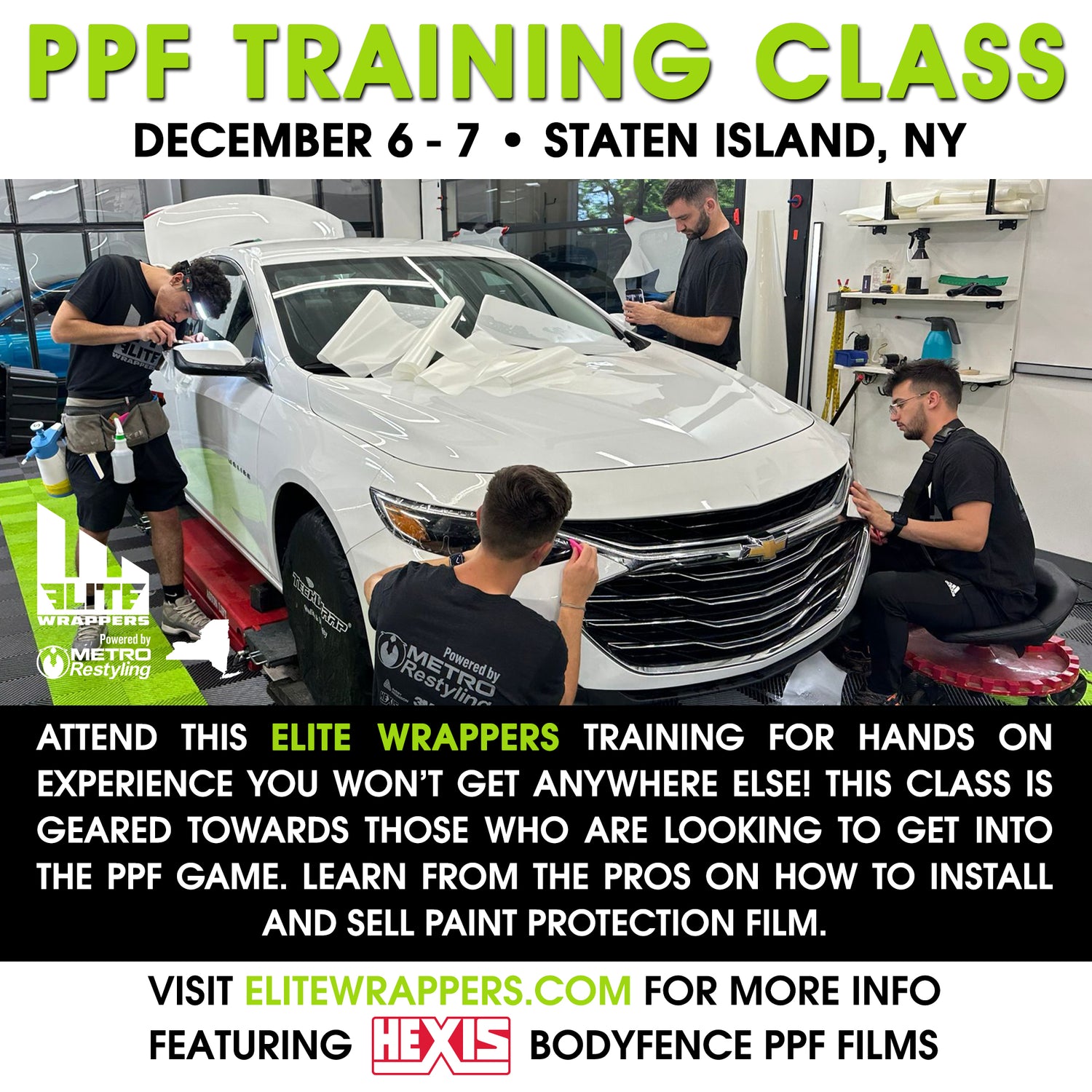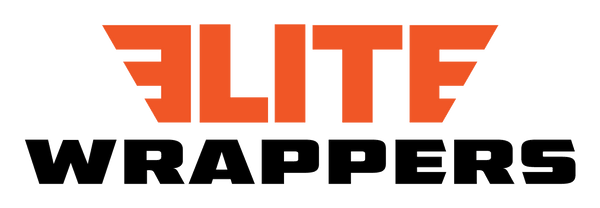
Ultimate Guide on Vinyl Squeegees
Share
Vinyl squeegees appear like essential equipment in vehicle wrapping, yet their value is unparalleled. One of the most often used instruments in the wrapping process, learning how to utilize a squeegee may make all the difference in the wrap's appearance between perfect and imperfect. Whether you recently graduated from Elite Wrappers' courses or are an experienced expert, this guide will help you improve your squeegee techniques and make wise choices on the correct squeegee for your projects.

Squeegee Holding Technique
Your vinyl wrap installation's quality depends much on how you handle your squeegee. The correct angle and technique will help avoid frequent problems, including creases, bubbles, and wrinkles, guaranteeing a professional result.
1. The Ideal Angle
Approach the vinyl, holding your squeegee at a 30-degree angle. This particular angle lets you apply roughly ½ inches of vinyl at a time, improving your application control. The squeegee should run directly across the vinyl to provide equal pressure and prevent needless material compression or stretching.
2. Avoiding Typical Errors
It is expected to want to curl down after every stroke, but it might cause problems. Curving down creates unequal pressure and may produce air bubbles or wrinkles. Apply constant pressure across the stroke and always squeeze straight forward.
3. Organizing Big Images
Larger graphics installations call for careful vinyl management. Once you have applied the top two inches of the graphic, snap the vinyl up to your application line. Although this line may not be quite straight, raising roughly ½ inches of the applied vinyl helps align the rest of the graphic without stressing it excessively. Holding the vinyl gently without tension lets the adhesive stick naturally to the substrate.
4. The 90° Angle
Never hold your squeegee at a 90-degree angle. This method gathers extra material and compresses the vinyl to create wrinkles. The key to a proper application is tilting the squeegee back to roughly 30° and running it straight across the graphic.
Understanding the various Types of Vinyl Wraps available on the market can further enhance your application technique and material choice.

Making Use of a Felt Squeegee
Felt squeegees are essential tools, especially when working on curved surfaces or recessed regions. They provide the adaptability required to fit these demanding shapes, lowering the possibility of creases and wrinkles.
1. The Function of Adaptability
Generally ½ inches thick, felt squeegees are made to fit the surface they are operating on. Their adaptability makes them perfect for places where a stiff squeegee would struggle, such as around bends or in deep recesses.
2. Guarding Fragile Vinyl
Some vinyl materials, including chrome wraps, are delicate and easily scratched. One guarantees a perfect finish by avoiding these scratches using a soft felt squeegee. To keep your squeegee effective, you should routinely replace the buffer.
3. Method of Squeegeeing
Using a felt squeegee, the same ideas of angle and pressure hold. Holding the squeegee at a 30-degree angle, make continuous pressure in straight, overlapping strokes. This method locks the vinyl without adding creases or air bubbles.
The correct angle and technique vary slightly depending on the material you are working with. Learn more about the differences between Cast vs. Calendered Vinyl to choose the right approach for your wrap.
Selecting a Correct Squeegee
Choosing the suitable squeegee for your project is equally crucial as perfecting the method. Several different squeegees on the market are intended for particular jobs and materials. Here are some excellent suggestions:
1. Metro Restyling ProGlide Scratchless Squeegee
One adaptable tool for wet and dry use is the Metro ProGlide™ Scratchless Squeegee. Perfect for delicate surfaces like chrome, matte, and gloss automobile covers, it combines Teflon with a soft, silky suede edge. Easy gliding of this squeegee across painted surfaces and vinyl films helps to lower the chance of markings, scratches, or damage.
2. Metro Teflon Squeegee, 4" and 6"
Made in 4—and 6-inch lengths, the Metro Teflon Squeegee is meant for accuracy and speed. Its Teflon construction guarantees a flawless application, preventing vinyl surface blemishes and scratches. This squeegee is used for applications ranging from vehicle wraps to graphics, stripes, decals, and sign creation.
3. Considering Sensitive Materials
Choose a gentler squeegee, such as the ProGlide, when working with delicate vinyl materials, such as chrome or specialized finishes. Generally speaking, a medium-hard squeegee strikes a decent balance between durability and flexibility.

Advice for Good Squeegeeing
Learning the squeegee calls for more than just holding it right. These pointers will help you to guarantee a perfect wrap every time:
1. Correct Grip
Your squeegee grip will significantly influence your control and pressure. With your thumb on one side of the squeegee and your four fingers close together on the other, holding the squeegee near the buffer lets you make controlled, even motions and apply equal pressure.
2. Simplify the Vinyl First
Always gather the vinyl wrap material and flatten it before starting squeegeeing. Only squeegee once the material's wrinkles are eliminated if they exist. Trying to squeeze over wrinkles will worsen things and cause an annoying installation.
3. Crossing Strokes
Work with overlapping strokes instead of running your squeegee exactly one pass. This method guarantees no missing places and keeps air or water from collecting under the coating. A good quality finish depends mostly on consistency and enough pressure.
Last Thoughts
Anybody working on a vehicle wrap must be skilled in using a vinyl squeegee. By knowing the necessary techniques, selecting the appropriate squeegee, and adhering to the highest standards, you will have a perfect finish every time. This comprehensive guide offers the knowledge and advice you need to succeed, whether your experience level is new or you want to hone your abilities. Recall that the secret to a flawless wrap is the small details, so spend some time honing your squeegee technique.
To learn more expert tips, take our Elite Wrappers car wrap course! There you will learn expert tips from industry leaders on squeegee tips!

FAQ:
Q: How often should I swap out the squeegee's buffer?
A: The buffer should be routinely replaced when working with delicate vinyl materials. A worn buffer could cause uneven pressure or scratches, affecting your wrap's quality.
Q: Can I apply chrome vinyl using any squeegee?
A: Chrome vinyl is incredibly delicate and requires a light or medium-hard squeegee to prevent scuffs. The Metro ProGlide Scratchless Squeegee is excellent for chrome wraps.
Q: From what perspective would one best hold a squeegee?
A: Generally speaking, most vinyl wrap applications benefit from a 30-degree angle. This angle lets you apply constant pressure and avoid typical problems, including creases and bubbles.
Q: Why do overlapping strokes matter?
A: Overlapping strokes guarantee the perfect adhesion of every vinyl element to the surface. This method keeps air or water from being caught behind the film, avoiding downstream problems.
Q: Can I run a squeegee over several projects?
A: While reusable, squeegees should be kept in good shape. To keep the squeegee functional, routinely clean it and substitute new buffers.

